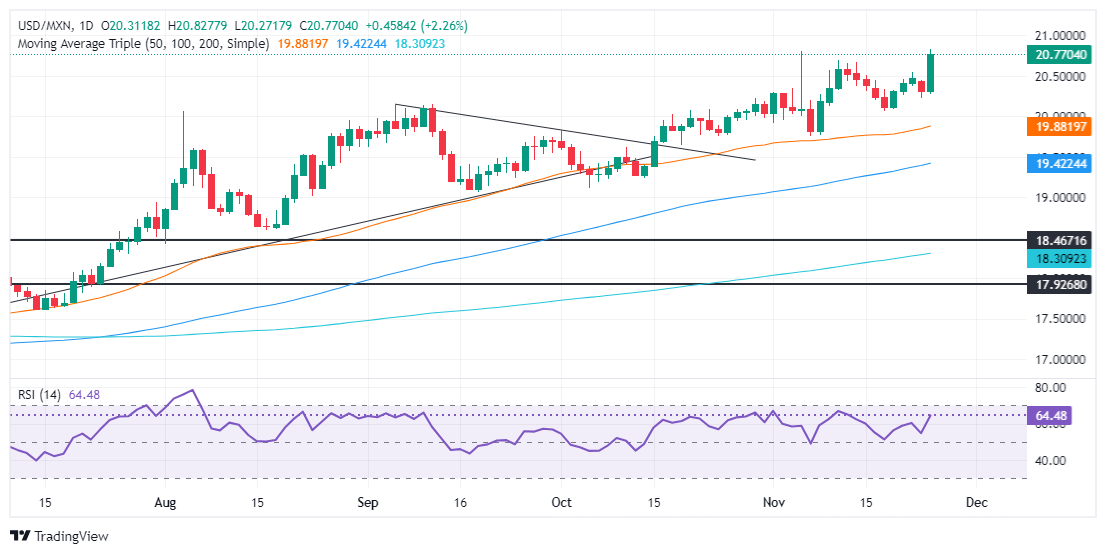Mexican Peso tanks as Trump threatens 25% tariffs, USD/MXN soars
- Mexican Peso plunges almost 2% on President-elect Trump’s harsh remarks on tariffs.
- Mexican President Sheinbaum warns of retaliatory tariffs, stressing US consumers could bear the brunt of trade war.
- Banxico's dovish stance and lower inflation expectations hint at further rate cuts, adding pressure to the Peso.
The Mexican Peso collapsed against the Greenback after US President-elect Donald Trump said on Monday that he threatened to impose 25% tariffs on Mexico. Trump blamed the country for not battling drug cartels enough and allowing the passage of illegal immigrants into the US. The USD/MXN trades at 20.77 at the time of writing, gaining more than 2%.
Late on Monday, Trump’s remarks lifted the USD/MXN from around 20.29 to its daily high of 20.74 before retreating somewhat during the European session. Nevertheless, as the North American session kicked in, the Peso remained pressured as the exotic pair advanced toward the 20.70 area.
In response to Trump, Mexican President Claudia Sheinbaum said, “One [US] tariff will be followed by another [from Mexico], and so on until we put common enterprises at risk.” She added, “The main victims will be US consumers” who buy manufactured cars from Mexico.
Aside from this, Mexico’s economic docket remains scarce on Tuesday, but it will feature the release of the Bank of Mexico's (Banxico) latest meeting minutes. Banxico unanimously lowered rates by 25 basis points (bps) on November 14 to 10.25% as expected.
Last week, Banxico Governor Victoria Rodriguez was dovish, hinting that the institution might look to decrease rates by more than 25 bps due to the progress on disinflation. Headline inflation during the first two weeks of November dipped from 4.68% to 4.56% YoY.
In the US, the economic docket revealed that Consumer Confidence improved above estimates and October’s reading. However, traders are awaiting the release of the Federal Reserve’s (Fed) last Meeting Minutes.
Ahead this week, the US economic docket will feature Durable Goods Orders, Initial Jobless Claims, and the Fed’s preferred inflation gauge, the Personal Consumption Expenditures (PCE) Price Index.
Daily digest market movers: Mexican Peso on the defensive amid scarce docket
- Mexico’s Chamber of Deputies, after approving the dissolution of autonomous bodies, proposed adjustments to the details of a contentious reform that abolished several regulatory bodies to ensure compliance with the USMCA trade agreement.
- “The fact that MORENA is taking a more cautious approach with two of the most important regulators, antitrust and telecoms, is a positive sign,” said Rodolfo Ramos of the Brazilian bank Bradesco BBI.
- The Conference Board’s Consumer Confidence for November expanded by 111.7 up from 109.6, exceeding estimates of 111.3
- The CME FedWatch Tool suggests that investors see a 59% chance of a 25-basis-point rate cut at the US central bank’s December meeting, up from 52% a day ago.
- Data from the Chicago Board of Trade, via the December fed funds rate futures contract, shows investors estimate 22 bps of Fed easing by the end of 2024.
USD/MXN technical outlook: Mexican Peso plunges as USD/MXN climbs above 20.70
The USD/MNXN remains upwardly biased and approaches the current day’s peak of 20.76 on Trump’s remarks. A clear break will expose the year-to-date (YTD) high of 20.80, followed by the psychological 21.00 mark. If surpassed, the exchange rate would test the March 8, 2022, peak at 21.46, followed by the November 26, 2021, high at 22.15.
Conversely, if sellers clear 20.50, they would eye the previous year-to-date peak of 20.22. Once taken out, up next would be the 20.00 mark, followed by the November 7 low and the 50-day Simple Moving Average (SMA) around 19.75/86.

Mexican Peso FAQs
The Mexican Peso (MXN) is the most traded currency among its Latin American peers. Its value is broadly determined by the performance of the Mexican economy, the country’s central bank’s policy, the amount of foreign investment in the country and even the levels of remittances sent by Mexicans who live abroad, particularly in the United States. Geopolitical trends can also move MXN: for example, the process of nearshoring – or the decision by some firms to relocate manufacturing capacity and supply chains closer to their home countries – is also seen as a catalyst for the Mexican currency as the country is considered a key manufacturing hub in the American continent. Another catalyst for MXN is Oil prices as Mexico is a key exporter of the commodity.
The main objective of Mexico’s central bank, also known as Banxico, is to maintain inflation at low and stable levels (at or close to its target of 3%, the midpoint in a tolerance band of between 2% and 4%). To this end, the bank sets an appropriate level of interest rates. When inflation is too high, Banxico will attempt to tame it by raising interest rates, making it more expensive for households and businesses to borrow money, thus cooling demand and the overall economy. Higher interest rates are generally positive for the Mexican Peso (MXN) as they lead to higher yields, making the country a more attractive place for investors. On the contrary, lower interest rates tend to weaken MXN.
Macroeconomic data releases are key to assess the state of the economy and can have an impact on the Mexican Peso (MXN) valuation. A strong Mexican economy, based on high economic growth, low unemployment and high confidence is good for MXN. Not only does it attract more foreign investment but it may encourage the Bank of Mexico (Banxico) to increase interest rates, particularly if this strength comes together with elevated inflation. However, if economic data is weak, MXN is likely to depreciate.
As an emerging-market currency, the Mexican Peso (MXN) tends to strive during risk-on periods, or when investors perceive that broader market risks are low and thus are eager to engage with investments that carry a higher risk. Conversely, MXN tends to weaken at times of market turbulence or economic uncertainty as investors tend to sell higher-risk assets and flee to the more-stable safe havens.

